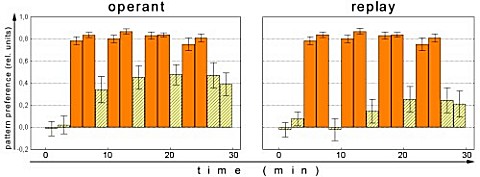|
While in recent years classical conditioning
has been established as an information transfer from the unconditioned
to the conditioned stimulus, the processes underlying operant conditioning
are still poorly understood. Modification of motor-programs in response
to reinforcement accounts for some but possibly not all cases. The Drosophila
flight simulator provides near perfect means to study the behavior
of animals that have been differentially (classically or operantly) trained
to perform the same learning task: avoiding certain pattern orientations
in their visual field.
Recording the sequence of conditioned and unconditioned stimuli during 2x4min of operant training and subsequently playing them back to a naive fly, does not yield any significant learning scores. This shows that there is indeed an important operant component in the original experiment. Increasing the amount of reinforcement by reiterating the replay training 4x4min, however, restores learning scores to near control levels. Thus, in the Drosophila flight simulator, the only difference to be found between classical and operant conditioning is the amount of reinforcement needed to accomplish the learning task (see figure below).  Apparently, whereas already the first 4 minute training block (orange) has a considerable learning effect (yellow, hatched) in the master flies, three such blocks are required for the replay flies to reach a similar performance. It becomes evident that the fly's active role in controlling pattern orientation and temperature (i.e. the operant) indeed is very important for the learning success. But what exactly is the role of the operant? How does it accomplish a quicker learning response? The transfer experiments were specifically designed to address this question. On my second poster entitled "Operant and Classical Learning at the Flight Simulator: What is the Role of the Context?" (PDF-format), I present the results of my transfer experiments (1997/98). At the time, I tested the hypothesis that it should not matter whether the fly was trained to avoid the patterns with one behavior and tested with another if it were true that the behavior only facilitated the learning about the patterns. The work was published in Learning & Memory and is available in PDF-format from this site. |